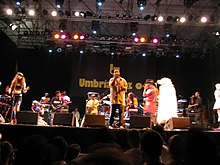P-Funk
| P-Funk | |
|---|---|
 George Clinton and Parliament Funkadelic | |
| Other names |
|
| Stylistic origins |
|

George Clinton and P-Funk All Stars, Long Beach 2009
P-Funk (also spelled P Funk or P. Funk) refers to the repertoire, musical style, and/or group of performers associated with George Clinton. The term is variously known as an abbreviation of Parliament-Funkadelic, Psychedelic Funk,[1]Pure Funk, or Plainfield Funk.
The P-Funk groups had their heyday in the 1970s and continue to attract new fans thanks both to the legacy of samples they bequeathed to hip hop and the live shows that the bands continue to perform. Their music was very aspirational, which is symbolized by their Mothership that has since been acquired by the Smithsonian. Notable P-Funk albums include Funkadelic's Maggot Brain and Parliament's Mothership Connection. The differing styles of these albums showcase the wide range of P-Funk's music. "Maggot Brain was an explosive record" of Jimi Hendrix inspired rock while Mothership Connection was an "album of science-fiction funk."[2][3] While this rock/funk differentiation is what normally separated Funkadelic from Parliament, the bands consisted of many of the same members and performed live on tour together. Hence, the two groups are often described under the one moniker Parliament-Funkadelic.
P-Funk recordings have been 'extensively' sampled in rap and hip-hop music, especially by Dr. Dre and other West Coast acts, beginning in the late 1980s and being particularly associated with the G-funk style of rap.[4]
Contents
1 Etymology
2 Musical characteristics
3 Key P-Funk artists
4 See also
5 References
Etymology
The etymology of the term P-Funk is subject to multiple interpretations. It has been identified alternately as an abbreviation of "Parliament-Funkadelic", "pure funk" or "Plainfield Funk", referring to Plainfield, New Jersey, the hometown of the band's original line-up. The liner notes of CD versions of the Motor Booty Affair album suggest that the "'P' stands for 'Pure.'" The breakout popularity of Parliament-Funkadelic elevated the status of P-Funk to describe what is now considered to be a genre of music in its own right.[5][citation needed]
Musical characteristics
According to Clinton, "We just took a combination of James Brown, Horn Players, Bootsy [Collins], Catfish, Sly Stone, took the funky psychedelic and rock ‘n’ roll elements together and called it P-Funk".[6]
Musical elements that characterize the P-Funk style include:
- spacey synthesizer melodies and washes provided by keyboardist Bernie Worrell and others
- classically trained and blues/jazz piano style of Bernie Worrell
- prominent, squelching electric bass lines provided by Bootsy Collins or performed in his style
- jazzy, insouciant horn section arrangements performed by The Horny Horns
- raucous glee club-type group vocals on songs' choruses alternating with sung or spoken vocals on the verses
- a mixture of funk and rock guitar styles, the latter being more prominent on Funkadelic's recordings
- steady, relatively unobtrusive drumming with few or no drum solos/drum breaks
- lyrics devoted to exposition of the P-Funk mythology, sex and drug-related humor, and sociopolitical satire often in the context of a concept album
- sophisticated use of multitrack recording technology and studio effects by producer George Clinton
- a more "live band" sound with little of the mechanistic precision of disco and post-disco dance forms[7]
Key P-Funk artists
- Bernie Worrell
Bootsy Collins/Bootsy's Rubber Band
- Eddie Hazel
- Fred Wesley
- Funkadelic
- Garry Shider
- George Clinton
- Maceo Parker
- Michael "Clip" Payne
- Michael Hampton
- Parlet
Parliament/P-Funk All-Stars
- The Brides of Funkenstein
- Walter Morrison
Zapp/Larry Troutman/Lester Troutman/Roger Troutman/Terry "Zapp" Troutman
See also
- List of P-Funk members
- List of P-Funk projects
References
^ Lauren Cochrane, "George Clinton: the best dressed man in music", The Guardian, June 23, 2008.
^ "Funkadelic: Funkadelic / Free Your Mind / Maggot Brain / America Eats Its Young Album Review - Pitchfork". pitchfork.com..mw-parser-output cite.citation{font-style:inherit}.mw-parser-output .citation q{quotes:"""""""'""'"}.mw-parser-output .citation .cs1-lock-free a{background:url("//upload.wikimedia.org/wikipedia/commons/thumb/6/65/Lock-green.svg/9px-Lock-green.svg.png")no-repeat;background-position:right .1em center}.mw-parser-output .citation .cs1-lock-limited a,.mw-parser-output .citation .cs1-lock-registration a{background:url("//upload.wikimedia.org/wikipedia/commons/thumb/d/d6/Lock-gray-alt-2.svg/9px-Lock-gray-alt-2.svg.png")no-repeat;background-position:right .1em center}.mw-parser-output .citation .cs1-lock-subscription a{background:url("//upload.wikimedia.org/wikipedia/commons/thumb/a/aa/Lock-red-alt-2.svg/9px-Lock-red-alt-2.svg.png")no-repeat;background-position:right .1em center}.mw-parser-output .cs1-subscription,.mw-parser-output .cs1-registration{color:#555}.mw-parser-output .cs1-subscription span,.mw-parser-output .cs1-registration span{border-bottom:1px dotted;cursor:help}.mw-parser-output .cs1-ws-icon a{background:url("//upload.wikimedia.org/wikipedia/commons/thumb/4/4c/Wikisource-logo.svg/12px-Wikisource-logo.svg.png")no-repeat;background-position:right .1em center}.mw-parser-output code.cs1-code{color:inherit;background:inherit;border:inherit;padding:inherit}.mw-parser-output .cs1-hidden-error{display:none;font-size:100%}.mw-parser-output .cs1-visible-error{font-size:100%}.mw-parser-output .cs1-maint{display:none;color:#33aa33;margin-left:0.3em}.mw-parser-output .cs1-subscription,.mw-parser-output .cs1-registration,.mw-parser-output .cs1-format{font-size:95%}.mw-parser-output .cs1-kern-left,.mw-parser-output .cs1-kern-wl-left{padding-left:0.2em}.mw-parser-output .cs1-kern-right,.mw-parser-output .cs1-kern-wl-right{padding-right:0.2em}
^ "500 Greatest Albums of All Time". Rolling Stone.
^ "Dr. Dre Perfected G-Funk, But He Didn't Invent It—Gregory Hutchinson Did". Complex. Retrieved 2018-07-24.
^ "P-Funk (aka Pure Funk) - Music Genres - Rate Your Music". rateyourmusic.com. Retrieved 2018-07-24.
^ "Delineating the funk with George Clinton | Crack Magazine". Crack Magazine. Retrieved 2018-07-24.
^ Borthwick, Stuart & Moy, Ron (2004). Popular Music Genres: an Introduction: "P-Funk made far more use of the metronomic four-to-the-floor drum styles, thus linking their funk to disco and jazz funk. However, unlike disco, P-Funk always sounded 'played', with little of the production-line precision of disco and post-disco dance forms." Edinburgh University Press (2004), p. 34,
ISBN 0-7486-1745-0